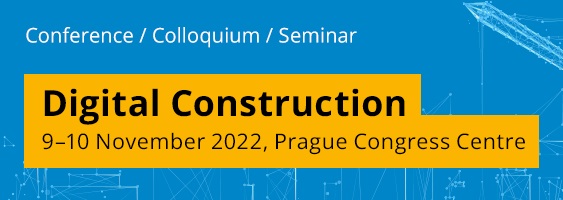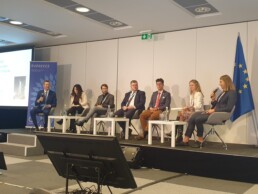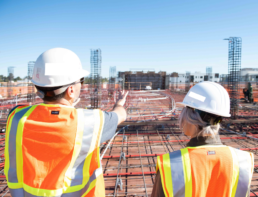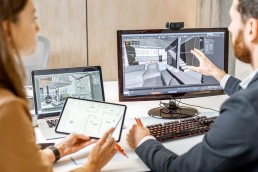Digital Construction Conference 2022 – Towards Construction 4.0 and the future of this sector in the digital era

On November 9th and 10th, the president of IBIMI-buildingSMART Prague participated in the "Digital Construction conference” organized by the Czech Ministry of Industry and Trade in Prague, in collaboration with buildingSMART Czech Republic, with the goal to outline the possible development paths of the sector towards Construction 4.0 .
Many representatives of buildingSMART International and of the individual national chapters attended the conference, confirming the importance of the role played by our community in the digital transformation of the building supply chain.
The construction industry is still the least digitized sector of all and, at the same time, one of the largest contributors to GDP in all European countries. Add to this the stagnant levels of labor productivity and the urgency of undertaking profound changes becomes evident.
The main purpose of this meeting was to find new solutions to stimulate the flow of data in the sector and accelerate construction processes through Building Information Modeling (BIM) and improve the technological and data ecosystem of the construction industry.
No less important, the other topics discussed included the introduction of digital transition and BIM in the public sector, the revolution in the acceleration of building permit processing, robotization, automation and prefabrication in the construction ecosystem.



The good news is that much-needed change is already underway. After decades of under-digitalization, the construction sector seems ready to start a new era. New analyzes of the construction technology ecosystem uncover emerging trends, solutions, and a growing universe of technology use cases that are revolutionizing the way we plan, design, and execute construction projects.
The development of robotics and 3D printers will be solutions not only to the lack of workforce in the construction industry but also to problems related to the safety of workers. For instance, for the reconstruction interventions in risk areas, a "hot" topic also supported by the CECE (Committee for European Construction Equipment https://cece.eu/) in relation to the recent events in Ukraine.
The discussion with Katharina Knapton-Vierlich, the new representative of DG Growth H1 construction, on "digital transition and BIM in the public sector", was very interesting. The goal is to identify a common digital development strategy between the Member States and the European Commission, which would support it with specific funding programmes. Topic of extreme relevance for buildingSMART. For this reason, the dialogue started in Prague will be deepened with the Commission during the buildingSMART summit to be held in Rome next March.

Extremely interesting was also the European Commission initiative on the Digital Building Logbook, with the goal of promoting transparency and greater availability of data for a wide range of market operators (property owners, tenants, investors, financial institutions and public administrations). The idea is to provide a guideline that catalogs and stores all the information deemed important for a Digital Building File in a format that synchronizes the methodologies used in the various member countries, also through R&I projects for the implementation of the Digital Register financed by the Commission.
At the end, it was also discussed the impact of this transformation on human resources, focusing in particular on training. The digitization of the supply chain must not be perceived as a threat by workers in the sector, but recognized as a way to improve the image and the working conditions in the industry. The right training courses and the right skills will in fact make the sector more attractive to younger workers. And it is precisely in this direction that buildingSMART International is going with the work at the tables of the Professional Certification Program (PCERT), the professional qualification program designed to provide a certificate compliant with local regulations and at the same time having international validity on skills in the BIM and openBIM.
Many of the points raised during the conference in Prague will be the subject of further debate and study at the buildingSMART International Standards Summit in Rome. We invite you therefore to continue following us and to join us on the occasion of the Summit.
SAVE THE DATE: buildingSMART International Standards Summit - Auditorium della Tecnica, Rome – 27/30 March 2023
Giulia Riccardi
Anna Moreno
Caterina Nissim
BIM and sustainability in the construction industry
The use of BIM and the holistic approach to sustainability in the construction industry
Energy savings, consciousness about natural resources, reduction of pollution and respect for the environment. The theme of green development of cities is a challenge in which the construction sector has a central role to play.
Fortunately, design and technologies are moving on an increasingly “green” track: architects are always more motivated by the desire to create buildings that create dialogues between man and nature. The cities of the future are (very) slowly and gradually developing obligations to comply with environment-friendly practices and standards which, for the sake of simplicity, we will call "sustainability".
Construction is an energy-intensive sector with a high share of global pollution: it is in fact responsible for 36% of energy consumption and 39% of carbon dioxide emissions into the atmosphere. This is the reason the sector has a huge responsibility and the duty to initiate better practices and virtuous processes to reduce its impact on the planet as quickly as possible.
Augmenting the sustainability in construction is not an easy problem to tackle and there are not fast lanes bringing there. There is a large number of different tracks to consider and we can only speak about sustainability in construction following an holistic and exhaustive approach.
Too often, in construction, the scale to measure sustainability is confused and reduced to specific energy requirements. In fact, also due to a regulatory framework that has not yet been defined in Europe and sustainability assessment procedures and methods that have not yet been established, building projects are defined as sustainable only if it somehow leads to energy savings in a phase of the project's life same.
Sustainability must instead lie in the achievement of an optimal balance between the fulfillment, at different moments in time, of economic, environmental and social requirements, often in conflict with each other. All these different factors must be evaluated in a holistic and integrated way by the designer, as by all the different actors during the lifespan of the project.
Managing this large amount of information is not simple, but the BIM approach can constitute the right solution to optimize processes and achieve all the objectives on the environmental and energy front.
BIM is still often confused with a simple 3D model of the project or even with an architectural software. It consists instead in a real integrated design methodology involving all the professional figures engaged in the design, construction and maintenance of the project, contributing to the different aspects of the work.
BIM appears as a digital representation of the physical and functional characteristics of a building. It allows to share knowledge and the complete information about the property, supplying therefore a reliable basis for any decision necessary throughout the life cycle of the structure. BIM can deliver different views and aspects of the same information, such as 2D drawings, lists, texts, 3D images, animations, as well as elements of time (4D) and cost (5D).
This information is available during the entire project life cycle: mechanical and electrical layouts, design details, materials and so on in a 3D virtual space. In particular, by also including the concept of Life Cycle Assessment (LCA) analysis, the project team is able to fully assess the environmental impact.
Using the LCA analysis, all actors involved in the construction can evaluate the trend of the environmental impact from the first steps of the work such as the production of materials passing through the installation and implementation up to their disposal. The BIM also in relation to the LCA makes it possible to optimize the performance of the building as every aspect (plant engineering, lighting, energy, etc.) is evaluated in a more conscious way, allowing the work team to turn towards sustainable and lower-impact choices on the environment.
The potential of the BIM methodology in information management can therefore provide valid support for implementing LCA directly in the BIM environment with the aim of simplifying the evaluation procedures and the understanding and use of the results. Furthermore, BIM represents for many construction companies and design companies a valid decision making tool in terms of costs, times and design solutions and by extending this opportunity also to LCA assessments, it can be used profitably as a tool for assessing environmental sustainability of civil works.
To conclude, the use of BIM in the construction industry will not save the planet. However, the impact of the construction industry is a particularly heavy one on the environment, with much room for improvement and a variety of solutions to consider, from new technologies to collaborative approaches. It is the moral duty of each of us to take the necessary steps to move forward a more sustainable future.
The role of ARISE in the implementation of the new RES directive
Anna Moreno, Caterina Nissim
The proposal for a new directive on the promotion of renewable energy sources
The DIRECTIVE OF THE EUROPEAN PARLIAMENT AND OF THE COUNCIL amending Directives (EU) 2018/2001 and 98/70/EC, and the Regulation (EU) 2018/1999 as regards the promotion of energy from renewable sources is a proposal presented in July 2021. Some of the amendments are related to the national system for the qualification system of designers and installers of Renewable Energy Sources (RES) and they are therefore relevant for the ARISE partners.
Let’s examine these modifications in more detail.
Addressing the shortage of competent installers
This proposed modification intends to provide more experts in the domain of designers and installers of RES technologies but also to give the opportunity to other innovative technologies to be promoted thanks to the support of proper qualifications and certification systems. Below, In italic, the original text:
Article 1(7) amends Article 18(3) REDII with adjusted paragraphs on the qualification and certification requirements of installers to deal with the fact that there is a shortage of installers of renewable heating systems, which is a ‘brake’ on phasing out fossil fuel systems. It also deletes the list of specific types of renewable heating technologies and replaces it by a generic reference to RES heating systems.
This proposition opens the market to innovative solutions. ARISE's objective is to deliver a common platform where the competences about the new technologies are based on knowledge, skills and the degree of autonomy following the European Qualification Framework (EQF). For example, the producer of a new technology will be able to provide both the list of the new competences needed to design and install the new system and provide the body of knowledge for training workers and designers. This way, the developers of the new technology will be able to upload to the platform the body of knowledge required to design and/or develop training materials on the correct use of the new technology.
Making a public list of installers a requirement in each Member State
The new directive makes the creation of a public register a requirement:
It amends Article 18(4) REDII by obliging Member States to put in place measures to support participation in training programmes. The previous possibility for Member States to make the list of qualified installers public becomes a requirement.
In the deliverable 2.4, to be published soon on the ARISE web site, we mention the heterogeneity of the Member States on the issue. In countries such as Ireland and the Netherlands, public registers are already required and managed by a national organism while other countries, Portugal and Italy to mention a couple, are still far from the target. In Italy, the qualifications for the installers are realised at regional level, making the development of a national register extremely complex. ARISE will present a solution on a European scale, as the certification of the single competences would provide the tools to develop a singular national/European register. For each technology, it will be identified a list of compulsory competences at European level and each country/region will be able to identify the designers and workers who own those competences.
Requiring transparency in certification schemes issued by Member States for a mutual recognition
In Article 18, paragraphs 3 and 4 are replaced by the following:
- Member States shall ensure that certification schemes are available for installers and designers of all forms of renewable heating and cooling systems in buildings, industry and agriculture, and for installers of solar photovoltaic systems. Those schemes may take into account existing schemes and structures as appropriate, and shall be based on the criteria laid down in Annex IV. Each Member State shall recognise the certification awarded by other Member States in accordance with those criteria.
The ARISE platform will provide the tools for mutual recognition. Each Member State will identify its need in competences for each specific technology by referring to the ARISE platform unit of competences. The need in competences are obviously different in each country, depending on the climate, national regulations and so on. Thanks to an adaptation of these needed competences in each different country on the ARISE platform, it will be possible for workers to move and relocate in different countries all over Europe.
Increasing the number of qualified installers covering renewable heating and cooling technologies
Member States shall ensure that trained and qualified installers of renewable heating and cooling systems are available in sufficient numbers for the relevant technologies to service the growth of renewable heating and cooling required to contribute to the annual increase in the share of renewable energy in the heating and cooling sector as set out in Article 23.
To achieve such sufficient numbers of installers and designers, Member States shall ensure that sufficient training programmes leading to qualification or certification covering renewable heating and cooling technologies, and their latest innovative solutions, are made available. Member States shall put in place measures to promote participation in such programmes, in particular by small and medium-sized enterprises and the self-employed. Member States may put in place voluntary agreements with the relevant technology providers and vendors to train sufficient numbers of installers, which may be based on estimates of sales, in the latest innovative solutions and technologies available on the market.
ARISE has conceived an “open platform” guaranteeing the opportunity, for any professional and worker, to reach the desired “maturity level” for any technology necessary for their work as self-employed or employee. The ARISE platform is also open to producers who wish to ensure that designers and installers own the right competences to design and install their technology correctly.
Public lists of qualified/certified installers
- Member States shall make information on the certification schemes referred to in paragraph 3 available to the public. Member States shall ensure that the list of installers who are qualified or certified in accordance with paragraph 3 is regularly updated and made available to the public.
ARISE will provide a system to certify the single competence through blockchain technology. This means that each competence acquired will be certified and it will not be possible to “manipulate” it. The union of all competences required by each Member State to perform a specific activity, will be identified in the same ARISE platform so that workers will know what the gaps consist in.
Accreditation of the training programs
- The accreditation of the training programme or provider shall be affected by Member States or by the administrative body that they appoint. The accrediting body shall ensure that the training programme offered by the training provider has continuity and regional or national coverage.
The training provider shall have adequate technical facilities to provide practical training, including sufficient laboratory equipment or corresponding facilities to provide practical training.
The training provider shall offer, in addition to the basic training, shorter refresher and upskilling courses organised in training modules allowing installers and designers to add new competences, widen and diversify their skills across several technologies and their combinations. The training provider shall ensure adaptation of training to new renewable technologies in the context of buildings, industry and agriculture. Training providers shall recognise acquired relevant skills.
The training programmes and modules shall be designed to enable life-long learning in renewable installations and be compatible with vocational training for first time job seekers and adults seeking reskilling or new employment.
The training programmes shall be designed in order to facilitate acquiring qualification in different technologies and solutions and avoid limited specialisation in a specific brand or technology. The training provider may be the manufacturer of the equipment or system, institutes or associations.
The ARISE partners do not intend to organize trainings themselves, but to support training institutions by providing the tools to train and qualify blue and white collars for each technology. The platform will be the hinge between two worlds: the technologies producers and the workforce. Training providers will be able to propose the right qualifications selecting the competences in the ARISE platform and accessing to the right training materials. A minor percentage of the fee charged for the courses will be directed to the ARISE platform managers to ensure a regular update of contents. The training providers will manage the access to the trainees who wish to certify their competences with blockchain through the platform.
ARISE’s ultimate goal is to revolutionise the learning process by changing both delivery and recognition of sustainable energy skills in the construction sector. The new system of training and recognition of skills will be valid across the EU, thus increasing the spread of skilled workforce in the building market. The ARISE platform will be the tool to facilitate the duty of any stakeholder of the building chain (owners, producer, training institutions, workers, designers, regional and national qualification organizations) and will substantially contribute to the mobility of workers and services in the building industry through all Europe and beyond.
Anybody interested in contributing to the testing of the platform, please contact us and join our Forum on LinkedIn to participate to open debates.
The Italian Strategy for the qualification of BIM Professional Roles
Over the course of the last few years, IBIMI has developed the so-called Italian OpenBIM roadmap. It is like a path in which to grow and consolidate as an association on a Italian national scale and to be able to give BIM professionals the opportunity to be certified internationally according to the certification programme of buildingSMART International, an international body that oversees the development of open standards such as the IFC format. Common language and shared process are the founding bases that BIM professionals involved in the management of information throughout the building or civil supply chain (survey, design, construction, use, decommissioning) must possess.
On this assumption IBIMI is at the forefront of the development of certifications for figures such as BIM Specialist, Coordinator and Manager. These certifications will cover one of the first important milestones of the buildingSMART certification programme together with the, already widespread in Italy, Individual Qualification on the foundations of BIM methodology.
The association aims to make these certifications and related courses, available by training providers, by the end of this year or by the beginning of next year. The vision is to be able to develop certifications for other types of BIM professionals in the coming years, such as the CDE Manager, site operator, and so on.
On this page you will find the link to download the full document "THE ITALIAN STRATEGY FOR THE QUALIFICATION OF BIM PROFESSIONAL ROLES": https://www.ibimi.it/download/



